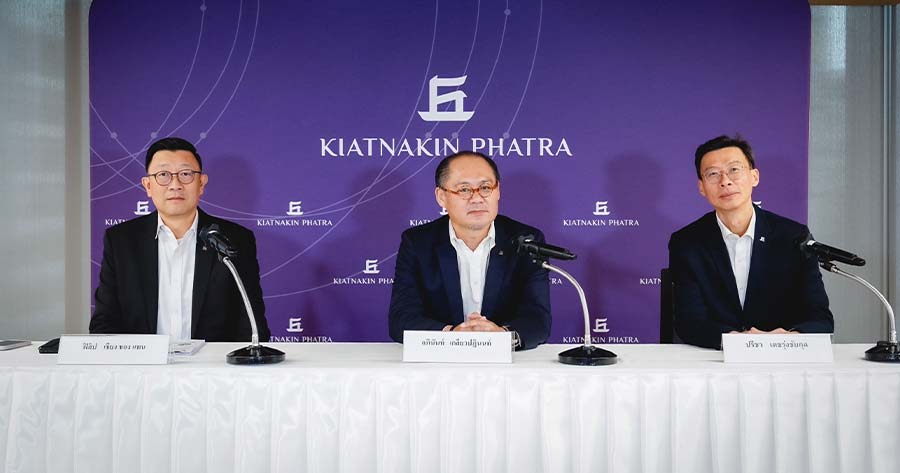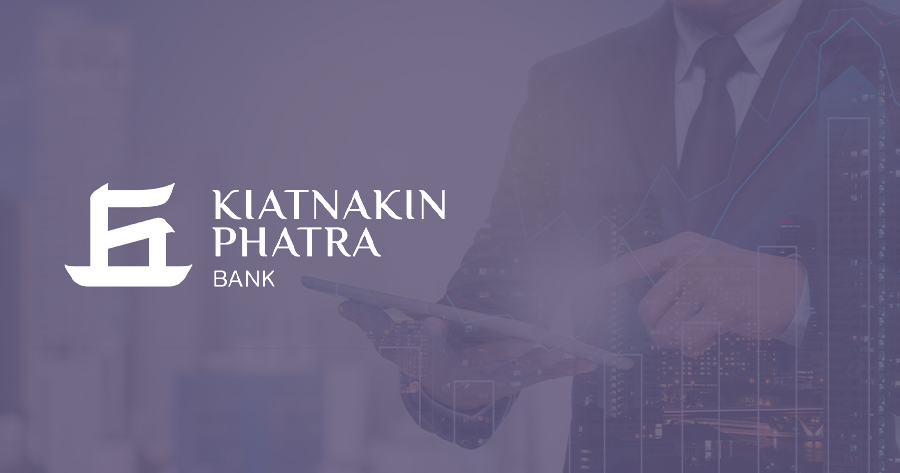Kiatnakin Phatra Financial Group (KKP) reveals its 2024 business direction to focus on three core businesses:
Commercial banking – to sustain quality credit growth and enhance operational efficiency to support the economies of scale;
Wealth Management – to gear up service with international benchmarking; and
Investment Banking – to leverage expertise in the industry to generate revenue from fees and create KKP’s income balance.
For the 2023 performance results, KKP’s profit decreased due to economic impact on auto hire-purchase loan customers and sluggish stock market. Nevertheless, KKP’s digital service channels, such as Dime and Digital Edge, were able to increase their customer base reaching more than 700,000 downloads. Mutual fund management’s assets under advice increased by up to 40 percent. For 2024, the loan growth target is set at 3 percent.
Mr. Aphinant Klewpatinond, Chief Executive Officer, Kiatnakin Phatra Financial Group revealed the business direction for 2024 that “Global trends in financial and capital markets suggest that businesses are now utilizing diverse channels to mobilize resources for their operations, instead of relying solely on bank loans. Therefore, KKP aims to scale up its three core businesses: commercial banking, wealth management, and investment banking, developing multiple channels to achieve robust and resilient growth in response to the economic system driven by change in information access, technology, and regulations. Commercial banking will be the main source of income that grows with balance sheet growth. Hence, we need to raise deposits to meet the increasing demand for loans. As for wealth management and investment banking, we will focus on improving services to international standards to generate revenue from fees, which is an efficient way to use a balance sheet with low credit risk.”
Mr. Philip Chen Chong Tan, President, Kiatnakin Phatra Bank Public Company Limited commented on the Bank’s performance that “In 2023, profit decreased due to economic conditions and interest rates affecting auto hire-purchase loan customers coupled with changes in car prices. In response, the Bank focused on quality asset management, which showed positive signs of improvement. It also expanded its market share in quality credit through KKP Auto Loan. For 2024, the Bank sets the loan growth target at 3 percent and will further develop digital service platforms, such as Digital Edge and Dime, to deliver the best service access and experience to customers.”
Mr. Preecha Techarungchaikul, Head of Finance and Budgeting, Kiatnakin Phatra Bank Public Company Limited commented on financial information for 2023 that “KKP had a net profit of THB 5,443 million, down by 28.4 percent. Comprehensive income was THB 5,452 million, part of which is a net profit of THB 1,078 million and a comprehensive income of THB 1,119 million from the capital market. In 2023, an additional provision of THB 600 million was set aside for a large-sized loan, driving a high NPL coverage ratio of 164.6 percent at the end of 2023. Furthermore, the Bank saw an increase in both net interest and non-interest incomes. Net interest income amounted to THB 22,294 million, up by 16.8 percent, while non-interest income was THB 6,469 million, down by 23.5 percent from 2022. The Bank had a BIS ratio of 16.2 percent, calculated according to the Basel III rules and included profits up to the end of 2023, and Common Equity Tier 1 ratio was 12.8 percent.”
KKP identifies four trends in 2024 which reflect a turning point for the Thai Economy, emphasizing the need for consensus for moving forward
Dr. Pipat Luengnaruemitchai, Chief Economist, KKP Research, Kiatnakin Phatra Financial Group, stated that there are four trends that need to be closely monitored in 2024 global economy:
- Growth divergence: While the global economy as a whole is slightly slowing down, a notable divergence is evident, particularly in the top two economies. The US is expected to grow more robustly than initially anticipated, while China is facing a slowdown.
- After reaching their highest levels, global interest rates are now showing signs of decline: As global inflation slows down, central banks around the world are gradually cutting interest rates. However, due to the robustness of the US economy, the Federal Reserve may not be able to substantially lower interest rates.
- International politics remains uncertain and has considerable implications for the global economy, particularly with factors such as ongoing wars and elections occurring in various countries worldwide, including the United States.
- Thai economy’s slow recovery, and end of rising interest rate cycle: The tourism sector’s steady rebound and the recovery of exports are the main economic drivers this year. However, uncertainties regarding the government’s economic stimulus policies could have a short-term effect. Thailand’s interest rate policy is expected to remain at 2.5% for most of the year, with a possibility for a rate cut if the government fails to deliver on its stimulus plans, or if the growth projections are not met.
In addition to short-term concerns, Thailand’s long-term economic prospect needs to be considered. Every time an economic crisis occurs, the Thai economy tends to recover with sluggish growth, especially after the COVID-19 crisis. Many anticipated that the Thai economy would return to normal growth after overcoming the COVID-19 crisis. However, after two years since the crisis, the Thai economy has yet to fully recover to its pre-crisis state. It is even recovering slower than expected.
The tourist sector, which was a vital engine before COVID-19, has not recovered to its pre-pandemic level due to the absence of Chinese tourists. While Thailand’s exports previously relied on the global supply chain like China as the gateway to the world market, over the past 2-3 years, the country has struggled to expand its global supply chain. It has also increasingly lost competitiveness and its trade balance with China has deteriorated in recent years, notably in key products, such as electronics, electrical appliances, steel, and electric vehicles (EVs). At the same time, the country faces severe structural issues, including challenges posed by an aging society, a declining workforce, long-standing educational quality problems, and a lack of investment over nearly three decades since the 1997 Asian financial crisis.
“The Thai economy has now reached a turning point. What is more important may not be that we are unaware of the problems or how to solve them, but rather we need to reach a consensus within society on how to begin to address these issues. It is a matter that needs to be openly discussed because resolving these challenges will take time, possibly decades, to see results.”
An illustrative case is Japan’s economic reform during the time when Shinzo Abe served as Prime Minister from 2006 to 2007 and 2012 to 2020. He introduced the “Three Arrows” policy, targeting monetary policy, fiscal consolidation, and economic reform, spanning various areas, including labor market, agriculture, corporate governance, regulations, competitiveness in the private sector, consumption tax increase, and Japan’s participation in trade agreements. Nevertheless, it took nearly a decade before the Japanese economy began to recover. Throughout this period, Prime Minister Abe dissolved the parliament multiple times, allowing the public to create a “political consensus.” This was essential as people experienced both benefits and drawbacks from the reform policies.



